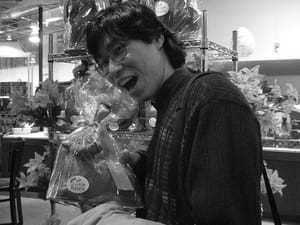In my yet-to-read list is Confessions of an Art Addict, a memoir of the legendary heiress and art collector Peggy Guggenheim. That’s right, of the Guggenheim Museum in New York and Bilbao in Spain. What follows, here, is a confessional, but with none of the glamour or moneyed lifestyle that’s popularly associated with being an “art collector” or “art dealer.” But, like Ms. Guggenheim, I admit it: I am an art junkie, and my poor man’s art collection on the walls repeatedly indicts me. An arts professional’s income barely supports the growing habit. And this past spring, I graduated from a master’s program for gallery management in New York City, thus exhausting over half my savings and leaving me in debt with school loans. A part of me is nagged by these questions: Why collect art? And, will this indulgence be my ruin?
I have a few paintings, several works on paper (including drawings and prints), some photographs, and at least one work that fits the category of sculpture. These things constitute my very modest, modern and contemporary art collection. There are smaller objets d’art, maybe better described as “post-Pop/Conceptual art tschotchkes” skirting the border between what’s artist-made and what’s mass-produced, like a plastic watch from 1992 designed by Jeff Koons. I also own a handful of what can be considered video art, either on tape or on DVD. And that’s not even getting to my fetish for acquiring art books and other ephemera (think postcards and posters).
How did I start? Back in college, I declared “Studio Art” as a second major partly because I thought, “Why buy beautiful paintings when you can make them yourself?” That did not quite work out, probably because I actually later grasped what a really good painter could produce. One day my instincts were good when an art teacher was giving away her friend’s apparently failed, throwaway canvases for re-use. Little did she know that I was developing an eye for sophisticated abstract painting, and I was familiar with some contemporary, emerging names. That’s how I became the deliriously proud owner of something that I suspect is by the hand of an artist who major art publications have credited with saving Painting (notice the capital ‘P’). Yes, I want to think I have a work by an important artist. No names will be leaked, and there is a good chance I could be wrong. But there is nothing more gratifying than owning something beautiful AND having a tantalizing story behind it.
A material way to keep time
Make no mistake: the artists I champion fall in the lineage of Pollock and Warhol more so than with M. C. Escher or Thomas Kinkade. The best art is perplexing, rather than easily digestible. An artist I am hooked on is Alfredo Martinez. Among art collectors it is said that one also “looks with the ears.” This means you pay heed to the buzz of the art press and gossip on the streets. In New York, I happened to walk into a gallery, and staring at me on one wall were these large, elegant, diagrammatic drawings of firearms. I remembered having read on Artnet.com about the notorious Martinez and his criminal conviction for his fakes and forgeries of Basquiat artwork. My heart began to beat even faster when I found their prices to be way below what I thought they deserved, an unbeatable bargain for my first art purchase. I learned that a highly regarded curator had purchased one, so I deliberated and plunked down my credit card—only minutes before another gentleman phoned his wife and snapped up the third and last remaining drawing on offer.
A young artist, Jonathan Cowan, gave me a very reasonable price on another favourite I own, a painting that holds several levels of possible meaning. Art like this acts like a good friend, letting this viewer think out loud without condescension. The painting is uniquely done on a common, dry erase board instead of on traditional canvas. I fell in love with the luscious surface created by applying careful layers of tinted gesso. The picture shows side-by-side depictions of the artist as a child sitting atop his father’s shoulders: one as a soft contour drawing, and the other a rendition drawn with child-like abandon in dense crayon. Description cannot do justice to the rest of the painting’s elements, but the knockout part is a crayon dangling from a long string which, forming a minimalist cross, corresponds to the drawn figures. If that weren’t enough, stencilled letters at the bottom read “saintchristop,” which only intensifies the intrigue. A deliciously sly painting, with a nod to Robert Rauschenburg, but holding its own.
My pack rat collection stems from some advice I received when I was volunteering for a gallery owner. He said that he always bought a piece for himself from every exhibition he puts on. It made sense to me. In a way, collecting art is just a material way to keep time. Writing about collectors, the curator Julia Brown said, “Collecting is intrinsically an activity of record, holding and safeguarding what has taken place in the present for the future. A bridge is created between the work of art in the studio and its place in the world.” Notice though that it has as much to do with the present and the future as with connecting to some past. In graduate school, a shrewd dealer intoned to our class, “You make money from what you sell, but you get rich from what you keep.”
Everyone collects something
The angst I feel as a poor art collector is mollified when I realize my aspirations are more than just about individual history. When I began to seriously love art, I’ll admit that I was not too different from storybook pirates who happily buried treasure in some hard-to-find island. Art collecting in that sense remains sort of an introverted luxury. However, it is no coincidence that the majority of my prized possessions were created by artists who are also friends. Collecting art is a social activity. It becomes obvious in the art trade that cold, hard cash—even billions of it—cannot alone guarantee acquisition of good material. As with any enterprise, integrity and character, my own and that of others, enriches all involved. Not being a millionaire, my esoteric habit is sustained by the generosity of talented artists I befriend. That is how I have smaller drawings from both Jonathan Cowan and Alfredo Martinez, stacks of abstract drawings by music composer Aenon Loo, spunky collaborative art by the TM Sisters, an assemblage by Rex Hausmann, and a print from Teressa Valla.
In a capitalist society, everyone collects something. Children instinctively gather rocks, dolls, and shells. Adults graduate to books, DVDs, designer clothes, jewelry, and business cards. Museums since the nineteenth century have become de rigueur for contemplation of ourselves and the larger world around us. In our day and age, there is talk of the monopoly of museums giving way to a potentially more democratic system of individuals opening their own privately controlled “museums” to the public. The more, the merrier. Maybe if I have interested people over to see my stuff, we can create a support group for like-minded nuts who collect the art of our time.
Collecting contemporary art may not be for everyone. My folksy Mauser pistol drawing by Alfredo Martinez may require some explaining, as will my balance sheets. But even if I don’t make a dime from my art investments, I am richer for it. And, I believe, so will be future generations.

